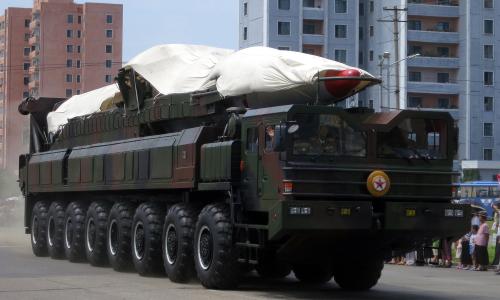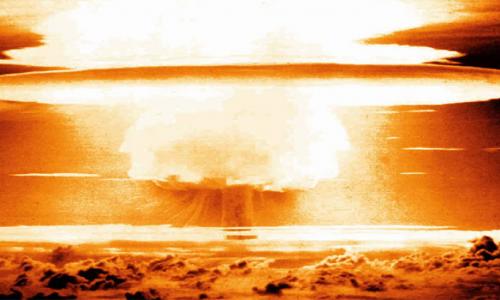The U.S. Department of Energy (DOE) has proposed the development of a new generation of nuclear warheads. Over the next several decades, the so-called Reliable Replacement Warhead (RRW) program would redesign and replace the entire U.S. nuclear arsenal with new warheads.
First funded at $9 million in Fiscal Year 2005 (FY05), the Bush administration's request for FY08 is $88.8 million in DOE funding for design and development work and $30 million for the Navy to plan to install RRW warheads on Trident missiles. Through FY12, the total proposed budget for RRW is $725 million.
New nuclear weapons are technically unjustified.
All the evidence indicates that the existing U.S. stockpile of nearly 10,000 nuclear warheads is highly reliable and that it will remain so for many decades. Based on an extensive testing and monitoring program at the three nuclear weapons laboratories, the Secretaries of Energy and Defense have certified to the President, each year since 1997, that all warhead types in the U.S. nuclear stockpile are safe, secure and reliable. In late 2006 the JASONs (an independent panel of scientists and engineers that has long advised the U.S. government on nuclear weapons issues) assessed data from plutonium "accelerated aging" experiments conducted at the nuclear weapons laboratories. The report concluded that the plutonium components in U.S. nuclear warheads have lifetimes of at least 85 years, and possibly much longer. Since the oldest warheads were built in the 1970s, the core nuclear components of current warheads will remain vital for at least another fifty years.
The initial design of the first new warhead, designated RRW-1, was recently approved, and a First Production Unit is planned to be built by 2012. It would replace the 100-kiloton W76 warhead deployed on U.S. Trident II submarine-launched ballistic missiles. Yet the W76 does not need to be replaced. A refurbishment program on the W76 is just beginning that will extend its lifetime for 30 years.
For the first time since the end of the Cold War, the DOE would task the nuclear weapons laboratories to design a new nuclear core (the Nuclear Explosive Package or NEP) containing the fission primary—with its plutonium "pit"—and the thermonuclear secondary device. A nuclear weapon consists of several thousand components, of which the NEP is considered to be the most reliable. The NEP has few moving parts and is inherently robust: in formal reporting, it has traditionally been described as 100% reliable. In contrast, the least reliable component of the weapon is the delivery system—the missiles or bombers that carry the warheads to their targets. Results from missile flight tests indicate that approximately 15% of the time, some type of delivery system failure would prevent the warhead from reaching its target.
The RRW could be "misunderstood by our allies, exploited by our adversaries, complicate our work to prevent the spread of nuclear weapons, and make resolution of the Iran and North Korea challenges all the more difficult."
~ Sam Nunn, Congressional Testimony, March 29, 2007
New weapons program will not yield nuclear reductions for decades.
Proponents of RRW maintain that the program will lead to reductions in the U.S. nuclear stockpile, particularly in the reserve, or "hedge," forces. By 2012, the United States plans to maintain some 6,000 nuclear warheads, including 2,200 operationally-deployed strategic weapons. The DOE has made clear that reductions below this level would await creation of a "responsive infrastructure" that could quickly build additional weapons, including new types, if judged necessary. According to DOE, creating this capability would require developing and producing several new types of RRW warheads, which would take two decades or more. Moreover, a U.S. infrastructure that could quickly produce a large number of warheads would raise concerns among other nuclear weapon states and be a barrier to deep reductions in nuclear arsenals worldwide.
New weapons will increase pressure for nuclear testing.
The DOE maintains that these new warheads can be deployed without conducting nuclear explosive tests. However, the United States has never certified and deployed a new nuclear warhead design without first conducting a series of full-scale nuclear explosive proof tests. Many weapons scientists are skeptical that a new warhead could be certified to be reliable and safe with the same level of confidence as our existing weapons without nuclear testing. In any case, there would be tremendous political and military pressure to test any new nuclear designs, if only to reassure future U.S. politicians, the military and our allies that the new warheads will work as designed.
We Need New Policies, Not New Weapons.
The RRW program would return the nuclear weapons laboratories to the Cold War cycle of nuclear weapon design, development and production. It would preserve and extend an irrational nuclear war-fighting posture left over from the Cold War that makes the United States less secure. Despite the end of the Soviet Union, the United States still maintains thousands of nuclear weapons on high alert, capable of being launched within minutes. This nuclear posture undermines U.S. nonproliferation goals and perpetuates the only current threat that could destroy the United States: a Russian nuclear attack—either accidental, unauthorized, or deliberate but based on false information.
Congress should eliminate funding for the RRW program. It is unnecessary: our current nuclear arsenal is safe and reliable. What is needed is a new nuclear policy that would lead to the elimination of nuclear weapons. Congress should begin now to consider what such a policy would look like.
For more information, contact Stephen Young, Washington Representative, at [email protected] or 202-331-5429.



